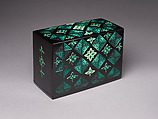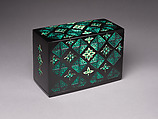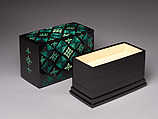Carved Lacquer Box “Green Flower”
Matsumoto Tatsuya Japanese
Not on view
This contemporary lacquer box was created with green and yellow lacquer, gold maki-e, and mother-of-pearl inlay applied on a wood base. The surface features an elegantly symmetrical arrangement of geometric and stylized leaf and floral motifs in varying shades of green with yellow against a lustrous black background. A traditional technique of lacquer carving called chōshitsu—introduced to Japan when Song-dynasty Chinese carved lacquers were imported during the Muromachi period (1392–1573)—was used to produce the multi-colored design. The artist applied dozens of layers of colored lacquer (urushi) to the wooden core. Each layer was allowed to harden, was polished, and then the succeeding layer was brushed over it. Once the multi-colored layering was complete and the lacquer sufficiently hardened, a blade resembling a small chisel, designed specifically for lacquer carving, was used to cut designs into the layers. The carving revealed the different colors, depending on the depth of the cutting, with the completed patterns standing out in relief. The sophistication of this technique is particularly visible in the central floral motif on the long side of the box, in which varying shades of green and yellow can be seen, along with fine details in gold maki-e (sprinkled gold), and mother-of-pearl inlay in the center of the “flower.” Such work is painstaking and time consuming; one object of this type can take between one and two years to complete. Following in the tradition of lacquer artisans of the past, Matsumoto Tatsuya has created lacquer vessels such as boxes, incense containers, incense burners combining classical methods of lacquer production with contemporary surface designs or motifs from other cultures, such as Persian floral patterns.
This image cannot be enlarged, viewed at full screen, or downloaded.
This artwork is meant to be viewed from right to left. Scroll left to view more.




